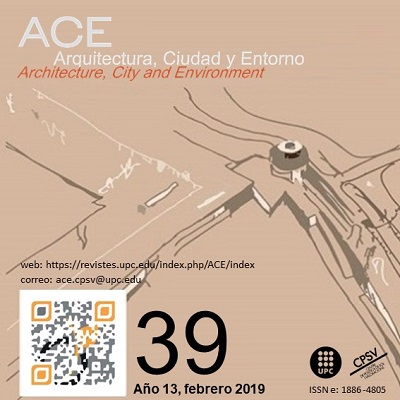Air cavity performance in opaque ventilated façades in accordance with the Spanish Technical Building Code
DOI:
https://doi.org/10.5821/ace.13.39.6487Keywords:
Efficient coating systems, air movement, building regulationsAbstract
Objective
The use and study of Opaque Ventilated Façades (OVF) has considerably expanded in recent years as an efficient envelope option when hoping to reduce cooling thermal loads for buildings. This is due to the solar protection provided by the outer layer and the ventilation from the air cavity. However, the actual situation in the air cavity of OVF buildings is usually very different from the theoretical studies, which do not consider the fixing systems of the outer layer regularly arranged inside the air cavity. This information is crucial to understand and validate predictions of the efficient behaviour of the system. Therefore, the objective of this work is to classify and analyse the performance of the air chamber in OVF existing buildings in Barcelona in accordance with current building regulations.
Methodology
Twenty-one buildings were surveyed and classified and the air movement and temperature inside the cavity was measured in ten buildings.
Conclusions
The findings show that although the Technical Building Code of Spain regulates the air cavity ventilation according opening minimums per linear meter, air inlet and outlet openings have the greatest influence on air cavity ventilation, even more so than open joint surface of the outer layer. For these reason, we recommend considering all OVF system variables within building regulations since there are significant variations of heat transfer regarding the physical and geometric characteristics of their elements.
Originality
The originality of the study lies in the survey and characterization of O in real buildings, and the results obtained by on-site measurements. This study is aimed at designers and construction professionals interested in the efficient performance of ventilated façade systems.
Published
Issue
Section
License
| INTELECTUAL PROTECTION CRITERIA |
At this moment, it is count with the "Oficina Española de Patentes y Marcas", while global protection it is being processed by the World Intelectual Property Organization (OMPI/WIPO). Nevertheless the International Standard Serial Number Office (ISSN) has given the following numbers ISSN: 1886-4805 (electronic version) and 1887-7052 (paper version). All articles will be peer reviewed, using double blind reviewing. |
| COPYRIGHT |
The article contents and their comments are authors exclusive liability, and do not reflect necessarily the journal editor commitee's opinion. All ACE published works are subject to the following licence CC BY-NC-ND 3.0 ES http://creativecommons.org/licenses/by-nc-nd/3.0/es/ It implies that authors do not hold nor retain the copyright without restrictions but only those included in the licence. |





































